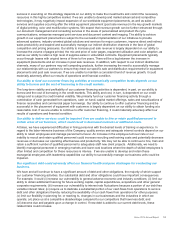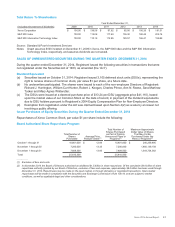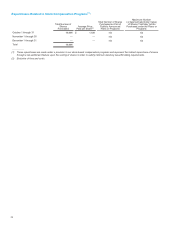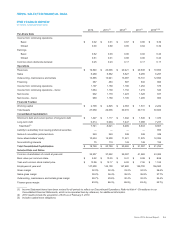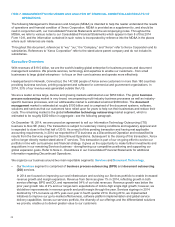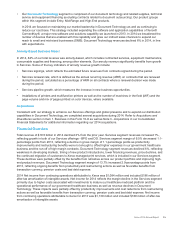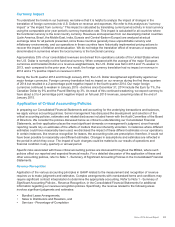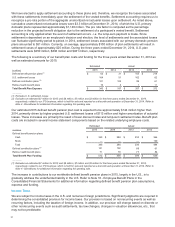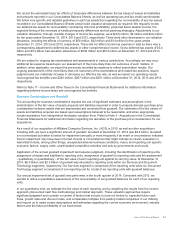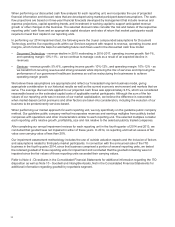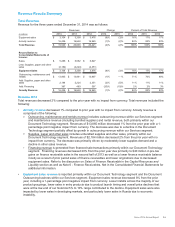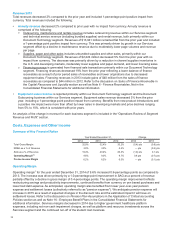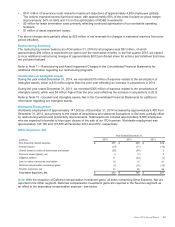Xerox 2014 Annual Report Download - page 43
Download and view the complete annual report
Please find page 43 of the 2014 Xerox annual report below. You can navigate through the pages in the report by either clicking on the pages listed below, or by using the keyword search tool below to find specific information within the annual report.Currency Impact
To understand the trends in our business, we believe that it is helpful to analyze the impact of changes in the
translation of foreign currencies into U.S. Dollars on revenue and expenses. We refer to this analysis as “currency
impact” or “the impact from currency.” This impact is calculated by translating current period activity in local currency
using the comparable prior year period's currency translation rate. This impact is calculated for all countries where
the functional currency is the local country currency. Revenues and expenses from our developing market countries
(Latin America, Brazil, the Middle East, India, Eurasia and Central-Eastern Europe) are analyzed at actual
exchange rates for all periods presented, since these countries generally have unpredictable currency and
inflationary environments, and our operations in these countries have historically implemented pricing actions to
recover the impact of inflation and devaluation. We do not hedge the translation effect of revenues or expenses
denominated in currencies where the local currency is the functional currency.
Approximately 33% of our consolidated revenues are derived from operations outside of the United States where
the U.S. Dollar is normally not the functional currency. When compared with the average of the major European
currencies and Canadian Dollar on a revenue-weighted basis, the U.S. Dollar was flat in 2014 and 1% weaker in
2013, each compared to the prior year. As a result, the foreign currency translation had no impact on revenue in
2014 and a 1% positive impact on revenue in 2013.
During the fourth quarter 2014 and through January 2015, the U.S. Dollar strengthened significantly against our
major foreign currencies. Foreign currency translation had no impact on our revenue during the first three quarters
of 2014 but resulted in a 2-percentage point negative impact in the fourth quarter 2014. Our major foreign
currencies continued to weaken in January 2015 - declines since December 31, 2014 include the Euro by 7%, the
Canadian Dollar by 9% and the Pound Sterling by 3%. As result of this continued weakening, we expect currency to
have about a 3 to 4 percentage point negative impact on full-year 2015 revenues, assuming rates at the end of
January 2015.
Application of Critical Accounting Policies
In preparing our Consolidated Financial Statements and accounting for the underlying transactions and balances,
we apply various accounting policies. Senior management has discussed the development and selection of the
critical accounting policies, estimates and related disclosures included herein with the Audit Committee of the Board
of Directors. We consider the policies discussed below as critical to understanding our Consolidated Financial
Statements, as their application places the most significant demands on management's judgment, since financial
reporting results rely on estimates of the effects of matters that are inherently uncertain. In instances where different
estimates could have reasonably been used, we disclosed the impact of these different estimates on our operations.
In certain instances, like revenue recognition for leases, the accounting rules are prescriptive; therefore, it would not
have been possible to reasonably use different estimates. Changes in assumptions and estimates are reflected in
the period in which they occur. The impact of such changes could be material to our results of operations and
financial condition in any quarterly or annual period.
Specific risks associated with these critical accounting policies are discussed throughout the MD&A, where such
policies affect our reported and expected financial results. For a detailed discussion of the application of these and
other accounting policies, refer to Note 1 - Summary of Significant Accounting Policies in the Consolidated Financial
Statements.
Revenue Recognition
Application of the various accounting principles in GAAP related to the measurement and recognition of revenue
requires us to make judgments and estimates. Complex arrangements with nonstandard terms and conditions may
require significant contract interpretation to determine the appropriate accounting. Refer to Note 1 - Summary of
Significant Accounting Policies - Revenue Recognition, in the Consolidated Financial Statements for additional
information regarding our revenue recognition policies.Specifically, the revenue related to the following areas
involves significant judgments and estimates:
• Bundled Lease Arrangements,
• Sales to Distributors and Resellers, and
• Services - Percentage-of-Completion
Xerox 2014 Annual Report 28


